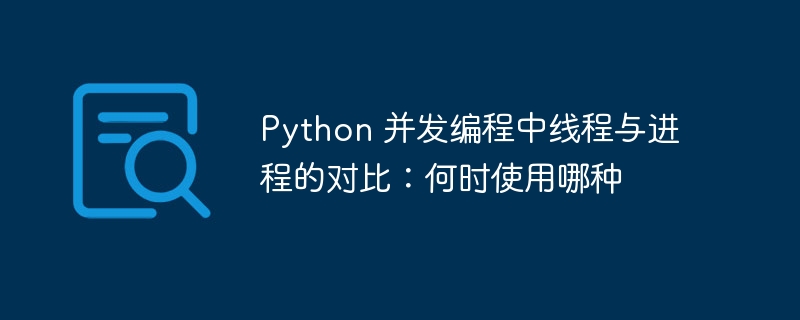Home >Backend Development >Python Tutorial >Comparison of threads and processes in Python concurrent programming: when to use which
Comparison of threads and processes in Python concurrent programming: when to use which
- PHPzforward
- 2024-02-19 15:20:03788browse

Threads and processes: concepts and differences
Thread is a lightweight execution unit that shares the same address space and resources with the process. They are created and destroyed quickly, which makes them very efficient when handling intensive tasks. However, threads cannot span multiple CPU cores because they are restricted by the Global Interpreter Lock (GIL).
Process is an independent execution unit with its own dedicated memory space and resources. They are heavier than threads and take longer to create and destroy. However, processes can span multiple CPU cores, allowing true parallelism.
When to use threads?Ideal situations for using threads include:
- Execute background tasks without blocking the main thread
- Processing multiple small tasks in parallel
- Share data without locks (protected via GIL)
Demo code:
import threading
def thread_function():
print("This is a thread.")
thread = threading.Thread(target=thread_function)
thread.start()
thread.join()# 等待线程完成
When to use process? Ideal situations for using processes include:
- Requires parallel processing across multiple CPU cores
- Need to isolate different memory spaces and resources
- Handling intensive tasks or long-running tasks
Demo code:
import multiprocessing
def process_function():
print("This is a process.")
process = multiprocessing.Process(target=process_function)
process.start()
process.join()# 等待进程完成
Performance comparisonThreads are more lightweight than processes and therefore are created and destroyed faster. However, due to the GIL, threads cannot fully utilize multi-core CPUs. Processes can span multiple CPU cores, allowing for better parallelism.
Disadvantages of threads and processes
Thread:
- Limited by GIL, cannot span multiple CPU cores
- Care needs to be taken when accessing shared data to avoid race conditions
process:
- Heavier than threads, takes longer to create and destroy
- The communication overhead between processes is large
In
python Concurrent programming , the choice between threads or processes depends on the needs of the specific application. Threads are great for processing intensive tasks, while processes are great for parallel processing across multiple CPU cores. By understanding their differences, you can choose the right tools to optimize your application performance.
The above is the detailed content of Comparison of threads and processes in Python concurrent programming: when to use which. For more information, please follow other related articles on the PHP Chinese website!

